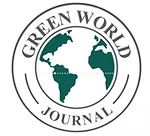Submissions
Comparte tu investigación con el mundo, de forma ética y transparente.
Descargar guía completa (PDF)1. General considerations
Green World Journal accepts original and unpublished contributions of scientific and academic nature. Manuscripts must not have been previously published nor be under consideration by another journal. All submissions undergo an initial editorial screening to verify relevance, quality, originality, and compliance with ethical standards. Those that pass this stage are subject to a double-blind peer review process, ensuring objectivity and transparency.
The average time for the first editorial decision is 45 days, and once accepted, the manuscript will be published online within 5 days.
2. Types of accepted manuscripts
-
Research articles: original scientific contributions with experimental, theoretical, or applied basis. Suggested length: 5,000–7,000 words.
-
Reviews and systematic reviews: comprehensive analysis of advances in a given field. Systematic reviews must comply with PRISMA guidelines.
-
Academic essays: critical or theoretical reflections on specific topics.
-
Short communications and technical notes: preliminary findings of relevance or methodological innovations.
-
Book or document reviews: critical analysis of academic works relevant to the scientific community.
3. Manuscript structure
Submissions must be prepared in Word (.docx) using the official journal template. The following sections are recommended:
-
Title: concise, specific, and representative of the content.
-
Authors and affiliations: full names, institutional affiliation, city, country, ORCID, and email of the corresponding author.
-
Abstract: maximum 200 words, single paragraph, including background, objective, methods, main results, and conclusions.
-
Keywords: between 3 and 10 terms.
-
Main body:
-
Introduction: problem statement, state of the art, and objectives.
-
Materials and Methods: detailed description of methodology to ensure reproducibility.
-
Results: clear and ordered presentation of findings, supported with tables and figures.
-
Discussion: interpretation of results and comparison with related studies.
-
Conclusions: key contributions, implications, and possible applications.
-
-
Final sections: acknowledgments, funding statement, authors’ contributions (CRediT taxonomy), data availability statement, conflict of interest declaration.
-
References: formatted according to ISO 690, listed alphabetically.
4. Style and formatting requirements
-
Use the International System of Units (SI).
-
Define acronyms and abbreviations at their first mention.
-
Number and caption all tables, figures, and schemes; include source when applicable.
-
Images must be of high resolution (minimum 300 dpi) and submitted in JPG, PNG, TIFF, or PDF formats.
-
Supplementary material (datasets, code, appendices, audiovisual material) may be included.
5. Ethical and legal considerations
-
Research involving human or animal subjects must comply with ethical standards and institutional/national regulations, with prior approval from an ethics committee.
-
Human studies require informed consent from participants.
-
Animal research must follow the 3Rs principle: replacement, reduction, and refinement.
-
Use of previously published material (figures, tables, or text) requires copyright holder permission.
-
All authors must approve the final submitted version and accept shared responsibility for the results.
6. Copyright and licensing
All articles are published under the Creative Commons CC BY 4.0 license, which allows copying, distribution, adaptation, and reuse provided proper credit is given to the authors and the journal.
Before submitting to Green World Journal, authors must ensure that their manuscript complies with the following requirements. Failure to meet these criteria may result in immediate rejection:
-
Originality and exclusivity
-
The submission has not been previously published and is not under review elsewhere.
-
-
Compliance with author guidelines
-
The manuscript follows the journal’s Author Guidelines, respects the required structure, and has been prepared using the official Word template.
-
-
Citations and references
-
All in-text citations correspond to the reference list.
-
References are complete, accurate, and formatted according to ISO 690.
-
A reference manager (Zotero, Mendeley, EndNote, etc.) is recommended for consistency.
-
-
Tables, figures, and supplementary material
-
Tables, figures, and schemes are numbered, captioned, and cited in the text.
-
Images meet the minimum resolution of 300 dpi and are provided in accepted formats (JPG, PNG, TIFF, PDF).
-
Permissions have been obtained for any previously published material.
-
-
Ethical compliance
-
All authors have provided explicit consent to be listed as contributors.
-
For studies involving humans or animals, appropriate ethics committee approval has been obtained.
-
A statement on conflicts of interest and funding sources has been included.
-
-
Final approval
-
The title and abstract are concise, clear, and self-explanatory.
-
The manuscript has been carefully reviewed for language and style.
-
All listed authors have reviewed and approved the submitted version.
-




